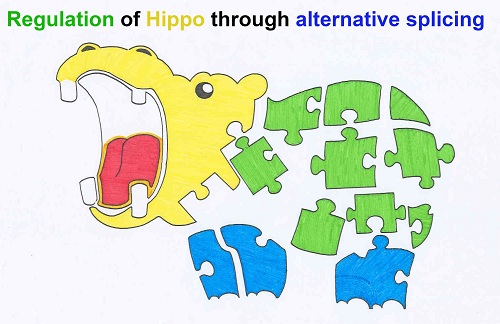
Yes-associated protein (Hippo-YAP) signaling is a key pathway that regulates cell proliferation and organ size, and its mis-regulation is closely associated with human cancer. In a recent paper published in Nature Communications, Dr. WANG Zefeng’s group from the CAS-MPG Partner Institute for Computational Biology (PICB), Shanghai Institutes for Biological Sciences (SIBS) of Chinese Academy of Sciences (CAS) and his collaborators from Dalian Medical University have reported that Hippo-YAP pathway can be controlled at RNA level through alternative splicing, which is altered in many cancers to amplify Hippo-YAP signals.
This study for the first time demonstrates that Hippo-YAP pathway is regulated through RNA splicing, which probably exemplifies a new general regulatory mode of cell proliferation in RNA level.
According to the current model, the activity of Hippo-YAP pathway is mainly controlled through protein phosphorylation and degradation. In this study, researchers have found that one important effector of Hippo-YAP pathway, TEA domain family member (TEAD4), is under control by alternative splicing. Through this new splicing switch, a truncated isoform of canonical TEAD4, TEAD4-S, will be produced, which lacks N-terminal DNA-binding domain, but contains YAP-interaction domain.
Therefore, TEAD4-S suppresses the translocation of YAP from cytoplasm to nucleus, and thus acts as a dominant negative isoform to YAP activity. Through this mechanism, overexpression of TEAD4-S suppresses proliferation and migration of cancer cells, and inhibits tumor growth in xenograft mouse model.
Furthermore, the researchers showed that splicing of TEAD4-S is facilitated by the tumor suppressor RNA-binding protein 4 (RBM4). Consistently, TEAD4-S is reduced in human cancers, which might be able to explore as a new anti-cancer strategy because patients with elevated TEAD4-S levels have improved survival rate.
Under normal condition, YAP is translocated into nucleus to promote cell growth. However, the activation of Hippo causes YAP phosphorylation, leading to cytoplasmic retention and degradation of YAP. Because YAP lacks a DNA binding domain, the activity of YAP has to be mediated by transcription factor TEAD proteins that specifically recruit YAP to DNA to stimulate cell proliferation.
Altogether, these data reveal a splicing switch that serves to fine-tune Hippo-YAP pathway. Intriguingly, some key components of Hippo-YAP pathway undergo extensive regulation in RNA level through alternative splicing. However, the biological functions of these isoforms are unclear.
Alternative splicing is a key mechanism to increase coding complexity of human genome, and alternation of splicing is a major hallmark of cancer. It is expected that splicing mis-regulations of other genes in Hippo-YAP pathway also play critical roles in cancer development and thus should be explored as a new route of potential cancer therapy.
The study is supported by grants from the National Natural Science Foundation of China and the Thousand Talent Program for Young Outstanding Scientists.

Figure: This figure shows the regulation of Hippo through alternative splicing. (Image by Dr. WANG Zefeng’s Lab)

86-10-68597521 (day)
86-10-68597289 (night)

86-10-68511095 (day)
86-10-68512458 (night)

cas_en@cas.cn

52 Sanlihe Rd., Xicheng District,
Beijing, China (100864)

